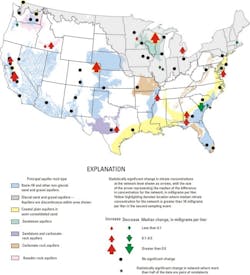USGS report examines status of groundwater quality
There was no change in concentrations of chloride, dissolved solids, or nitrate in groundwater for more than 50 percent of well networks sampled in the study that compared samples from 1988 to 2000 to samples from 2001 to 2010. For those networks that did have a change, seven times more networks saw increases as opposed to decreases.
"By providing a nation-wide, long-term, uniformly consistent analysis of trends in groundwater quality, communities can see whether they belong in the group of more than 50 percent which are maintaining their water quality, or within the group of more than 40 percent for which water quality is back sliding," said USGS Director Marcia McNutt. "Communities in the latter group can decide whether and what action may be warranted to address quality issues so they do not cause concern to human health."
Though chloride, nitrate, and dissolved solids occur naturally in the environment, human activities can cause concentrations to exceed levels that would be found naturally. At high concentrations, these chemicals can have adverse effects on human and environmental health.
High levels of chloride and dissolved solids in water don't present a risk to human health, but are considered nuisance chemicals that can cause the water to become unusable without treatment because of taste or hardness. Additionally, these chemicals can have adverse effects on ecosystems in streams and rivers when they discharge from the groundwater to these water bodies.
Excessive nitrate concentrations in groundwater have the potential to affect its suitability for drinking water. Also, when nitrate-laden water is discharged from groundwater to streams, the nitrate can end up in downstream water bodies, such as the Gulf of Mexico, and cause algal blooms. These algal blooms lead to low oxygen zones, which can be deadly to aquatic life.
Chloride, dissolved solids, and nitrate have many sources, including agricultural fertilizers, wastewater disposal, and runoff from salt used for deicing or other chemicals. Understanding changes in groundwater quality may help assess the effectiveness of management practices that have been implemented to control these sources.
"This type of long-term trend analysis is crucial for assessing whether the nation's groundwater is adequately protected from excessive concentrations of these potential contaminants," said Bruce Lindsey, lead scientist on the report. "USGS is uniquely positioned to provide this type of nationally consistent, scientific information to managers at the federal, state, and local level, so that they can make decisions that protect people and the environment."
Though a majority of the well networks tested saw no change, chloride concentrations increased in 43 percent of the well networks from the first decade to the second decade of study. Dissolved solids concentrations increased in 41 percent, and nitrate concentrations in 23 percent of well networks.
Although concentrations of these three constituents generally meet their respective EPA drinking water standards or guidelines, the proportion of samples exceeding the limits for nitrate and dissolved solids increased significantly over the decadal period at the national level.
Other important findings include:
* The largest increases in chloride concentrations were in urban areas in the Northeastern and Upper Midwestern United States, including suburban Boston, Chicago, Detroit and Milwaukee.
* Dissolved solids concentrations increased throughout the nation, including areas of Florida, Illinois, and the Rio Grande region.
* The largest increases in nitrate concentrations were in key agricultural areas, including the Great Plains, areas east of Lake Michigan, and in California.
* The magnitudes of increases in concentrations in deeper groundwater used as a source of drinking-water supply were generally less than in shallow groundwater. However, the proportions of networks with increases for both deep and shallow groundwater were similar.
The analysis consists of samples from 1,236 wells in 56 well networks, representing major aquifers and urban and agricultural land-use areas. Samples for chloride, dissolved solids, and nitrate collected from 1988-2000 were compared to corresponding samples taken from the same well between 2001 and 2010.
The NAWQA program continues to conduct studies on long-term groundwater trends. This analysis, which provides an overview of current water quality conditions and trends over time, is an important foundation for future NAWQA studies that examine the causes of changing concentrations and generate water-quality forecasts.
This report, "Methods for Evaluating Temporal Groundwater Quality Data and Results of Decadal-Scale Changes in Chloride, Dissolved Solids, and Nitrate Concentrations in Groundwater in the United States, 1988-2010" as well as links to a series of interactive maps showing long-term groundwater trends, can be found at http://water.usgs.gov/nawqa/studies/gwtrends/.
###
